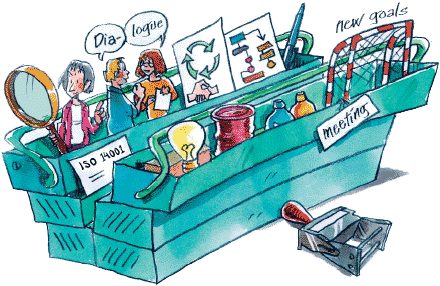An introduction to Life-Cycle Thinking and Management
10. The tool-box – how to keep the process going!

In the 1990's, in Denmark, the Ministry of the Environment put emphasis on lifecycle assessment as a decisionmaking tool to evaluate the most significant environmental impacts associated with a product. An enterprise will require various tools depending upon the goal(s) and the level of ambition for the environmental initiative, particularly if attention is directed towards marketing aspects of cleaner products.
There are tools suitable for at least three types of tasks:
- Assessment of the most significant environmental impacts from cradle to grave
- Ideas for environmental improvements to a product / ecodesign
- Environmental communication in the product chain and cooperation with interested partners
In addition, there are tools concerning consumer and market surveys, economic analyses, quality development, etc.The latter tools are outside the context of this report.
There is short discussion of the three types of tools below. Finally, there is a list of references to more detailed literature.
A) Life-cycle assement - enviromental impacts from cradle to grave
Depending upon the goal, a life-cycle assessment may be undertaken with three different degrees of detail which have very different requirements in terms of data collection and analysis.They are as follows:
Life-cycle thinking / conceptual life-cycle assessment involves a rough mapping of the relevant environmental impacts in the various phases of a product's life cycle. The goal of this type of assessment may be summarised in the following question: based on the existing knowledge regarding the environmental impacts from cradle to grave, how will an enterprise prioritise initiatives for improvements to a product's environmental profile?
The enterprise may undertake the assessment alone and the steps are the following:
| Obtain an overview over the phases of the life cycle and the relevant environmental impacts | |
| Use guidelines and rules of thumb | |
| Obtain ideas for immediate environmental improvements - "low hanging fruits". |
This type of assessment involves a qualitative evaluation of the enterprise's situation based on contact and discussions with relevant collaboration partners. (See Chapter 3 for suggested questions for discussion.) This evaluation may be supplemented with quantitative information based on key figures, standards, and common knowledge.
Simplified environmental assessment / lifecycle screening is used to identify the most important environmental impacts and life-cycle phases. This information can then be used to identify "hot spots" which should be assessed in greater detail. One tool which may be used in this process is the MEKA scheme (a Danish acronym for the words materials, energy, chemicals and other) which aims at making data collection and analysis more manageable.This involves:
| Identification of the significant environmental impacts and life-cycle phases | |
| Identification of hot spots | |
| Ideas for systematic environmental improvements to the product. |
In the past few years,Technological Information Centres (TIC), located throughout Denmark, have assisted a number of enterprises in using the MEKA method to perform an initial "life-cycle check".
A detailed life-cycle assessment provides information which will permit comparison of similar products, as well as detailed information regarding the most significant environmental impacts in the entire life cycle of the product.This assessment method is time consuming, requires extensive data collection, and specialised environmental expertise.Tools such as the computer program, SimaPro, from Holland or the Danish UMIP (an Danish acronym for Development of Environmental friendly Industrial Products) are helpful.
The majority of Danish enterprises will normally require assistance from an environmental consulting firm to conduct a detailed life-cycle assessment. Such an assessment involves the following:
| Identification of the most significant environmental impacts and lifecycle phases | |
| Documentation as a prerequisite for environmental product declarations and ecolabels | |
| Comparison of products. |
These three degrees of detail for assessment of a product's environmental impacts correspond in general to the three levels of ambition discussed previously (see Chapter 3).
Level of ambition |
Internal environmental commitment and readiness |
Environmental profile for a cleaner product |
Marketing a cleaner product |
Survey (analysis) |
Overview over life-cycle phases, authorities' requirements, etc. |
Simplified environmental assessment and user survey |
Detailed life-cycle assessment and market survey |
Goals |
Select initiative areas for environmental improvements |
Implement obvious environmental improvements |
Documentation of most important environmental impacts |
Cooperation |
Contact with relevant collaboration partners |
Cooperation among suppliers regarding documentation and environmental improvements |
Common routines for exchange of experience in the product chain |
Results (statement) |
Can respond to enquiries regarding a product's environmental profile |
Conforms to environmental criteria, for example public procurement guidelines |
Marketing of the product's environmental characteristics |
Figure 10.
Assessment of a product’s environmental impacts
The ambition level also determines how much time, and knowledge, and how many resources must be allocated to an initiative.The longer an enterprise moves to the right in Figure 10, the greater the time and expertise required. Expressed in another way, more detailed data collection requires more time and necessitates the involvement of a greater number of environmental specialists. However, it is only necessary to undertake a detailed life-cycle assessment if the enterprise wishes to market its product as environmentally better than the competitors.
B) Ideas for enviromental improvenments/ecodesigns
Internationally, there is a tradition of working with Eco-design and Design for the Environment.This begins with a lifecycle perspective, from which a number of ideas and guidelines regarding improvements to a product's environmental profile in each individual phase are generated.The approach puts focus on creativity and is actionoriented.
Philips operates, for example, with a "Fast Five" design approach where a proposed new product is compared to a reference product via the following five questions:
| Energy - does the proposed product design use less energy than the reference product? | |
| Recycling - is the new product more easily recycled? | |
| Hazardous waste - does the proposed product contain less chemical waste than the reference product? | |
| Product value - does the new design contribute to a longer product life, increase the desirability of the product and make it easier to repair? | |
| Service - is this a new way to provide a service with fewer environmental impacts? If the answer is YES five times then the proposed new product is an excellent alternative. |
If the answer is "yes" only three times, then the product is considered to be an interesting alternative, but one which still requires some improvement. A single "yes" means that the designer ought instead to consider upgrades to the reference product.
There are a variety of decisionmaking tools to assist with eco-designs with names such as spider web, strategy wheel, eco-compass, etc. which emphasise a visual representation of the issues (see Figure 11).
Based on a rough assessment of a reference product, the existing product's environmental profile is presented graphically by giving the product a grade for each individual life-cycle phase.This provides the background for discussions regarding the goals for future product development. In addition, the environmental profile for the proposed product is sketched in with a grade for each phase.This visual presentation identifies clearly where a new product requires environmental improvements and may also assist in motivating product developers and other employees.
A spider-web approach is illustrated in Figure 11.The practical value of this tool may be further improved if each phase and each concrete action task are formulated in such a way that they address the common characteristics of the various product families (see the literature list).
Figure 11.
A product’s environmental profile (adapted from Brezet & van Hemel, 1997)
C) Environmental communication and product chain cooperation
A life-cycle-based environmental initiative with focus on developing and marketing cleaner products makes new demands on environmental communication with an enterprise's various partners (see also Chapters 8 and 9).There are a number of tools to assist in working systematically with environmental communication and dialogue within an enterprise and between enterprises.
When establishing more systematic environmental communication, an enterprise must determine the following:
| With which partners / interested parties does the enterprise wish to enter into dialogue? | |
| What are the partners' requests and goals regarding environmental dialogue? | |
| What messages will be communicated using which means? | |
| How does an enterprise develop a plan for environmental dialogue? | |
| How are credible environmental arguments constructed? | |
| How can the results of environmental dialogue be evaluated? |
The answers to these questions and others are answered in the literature list under "C".
